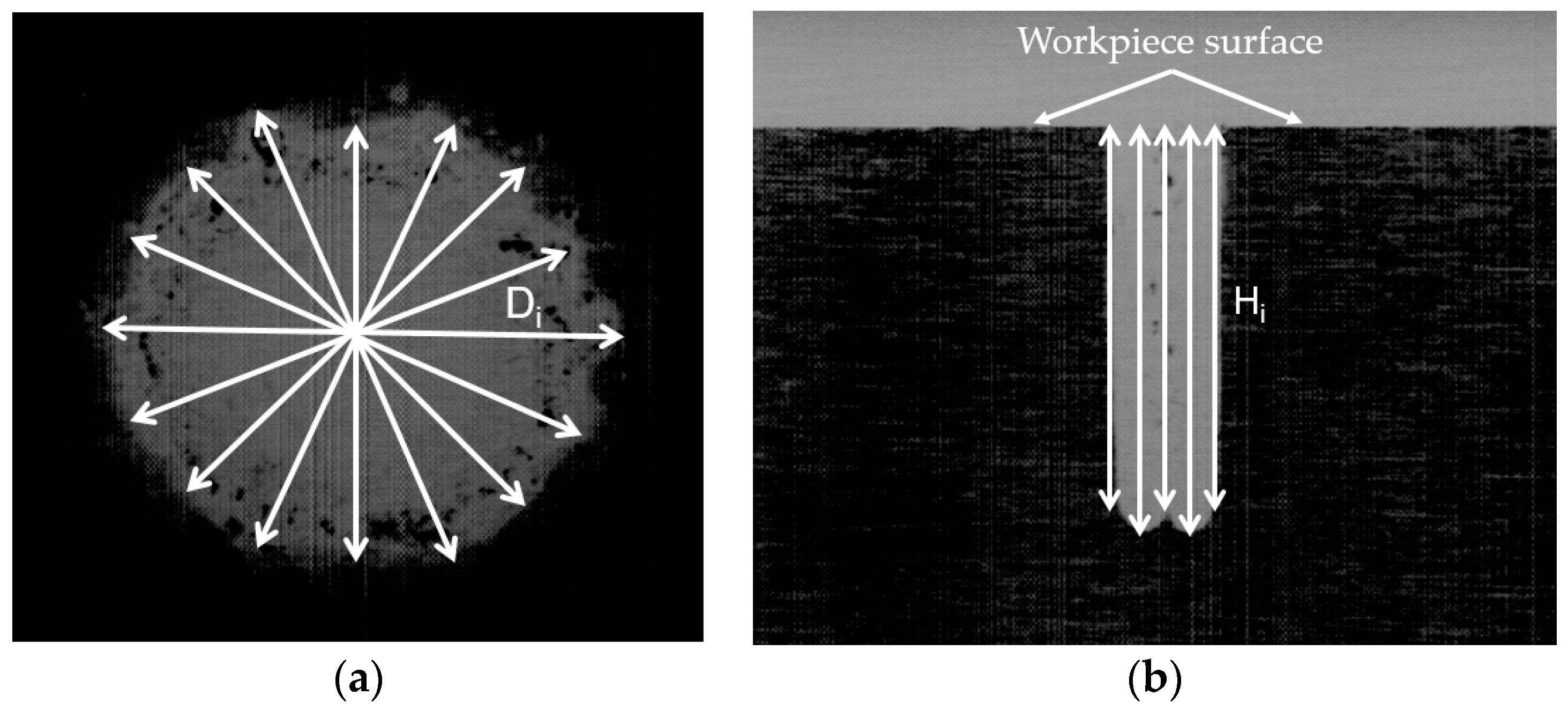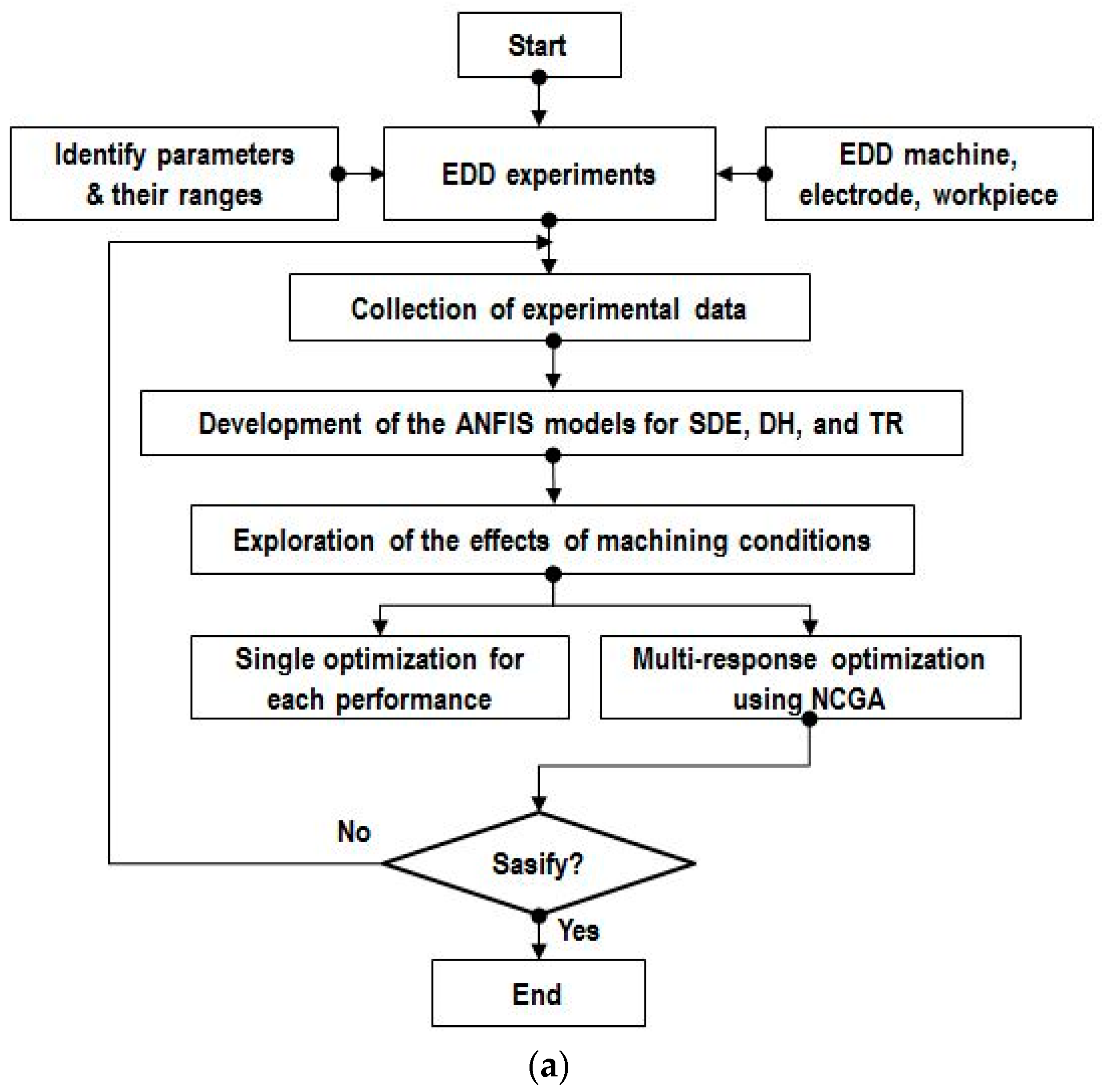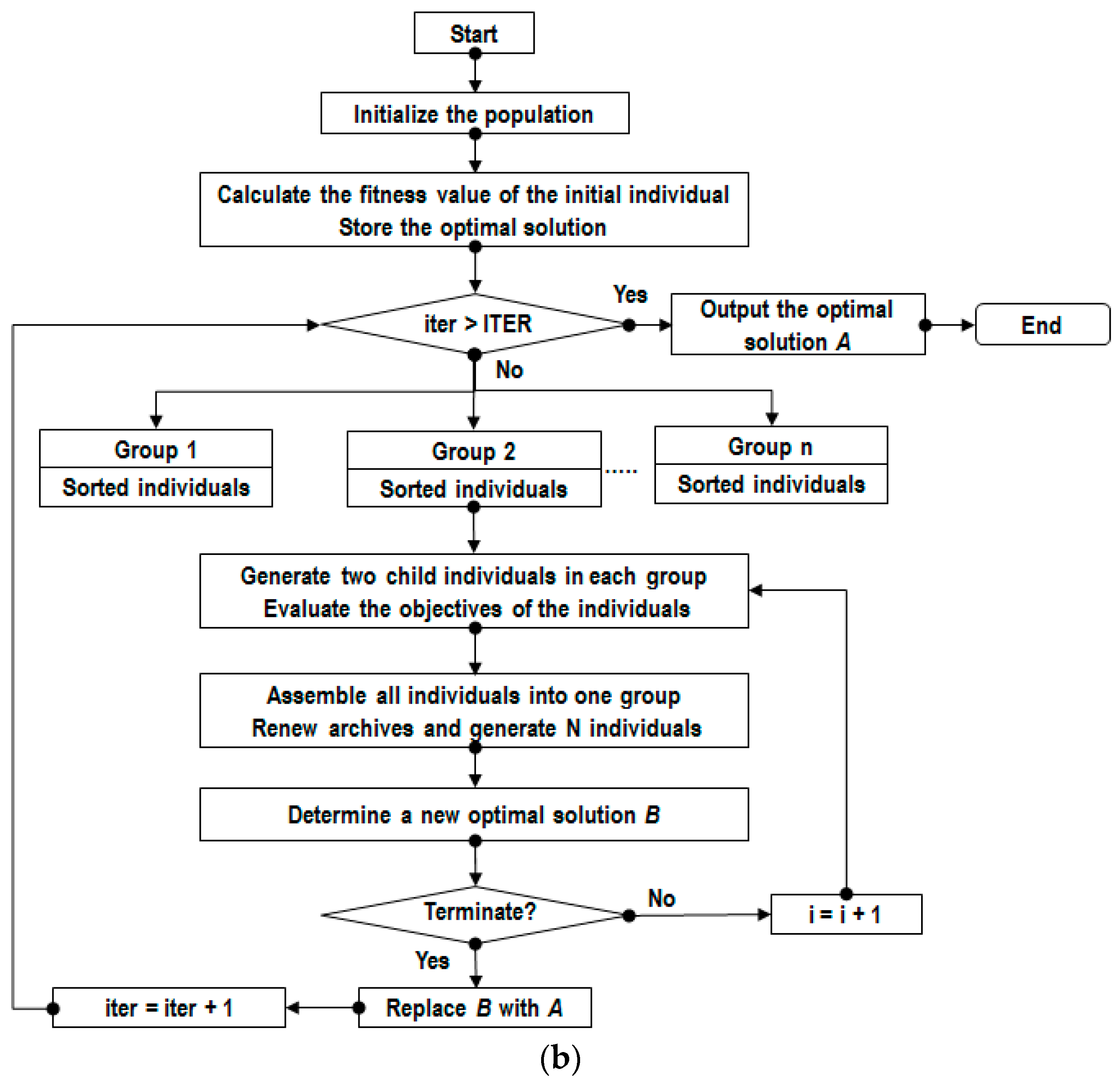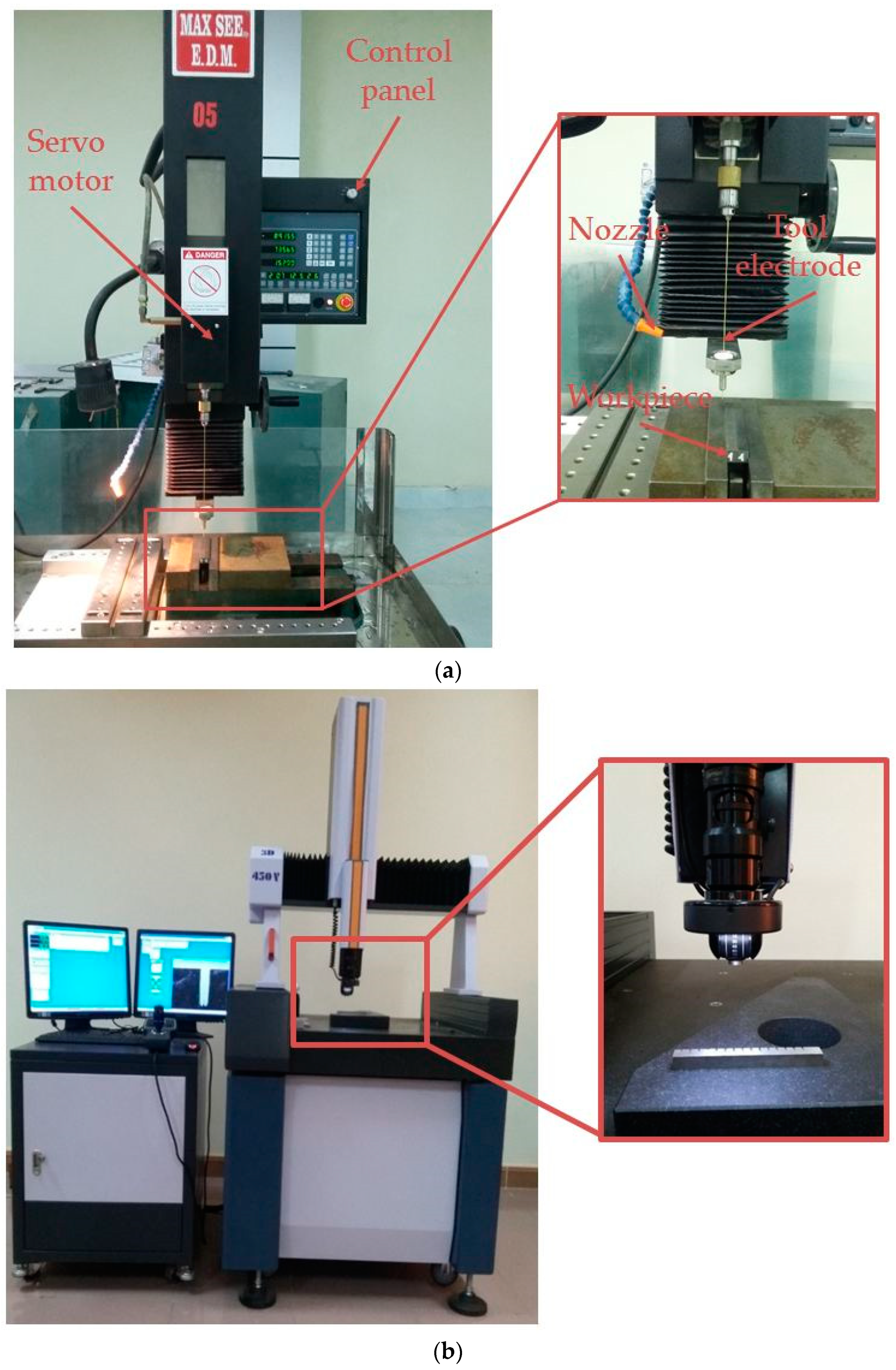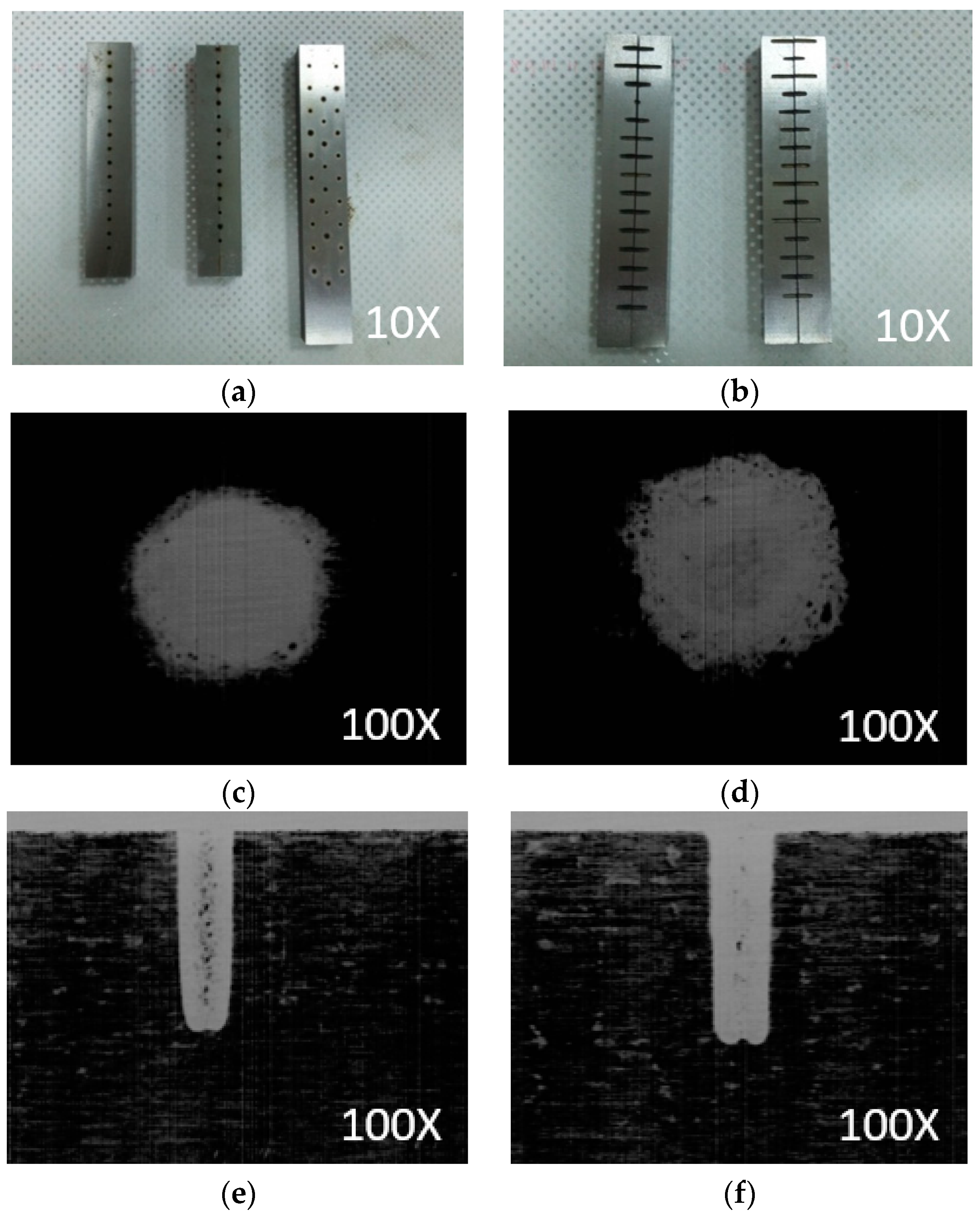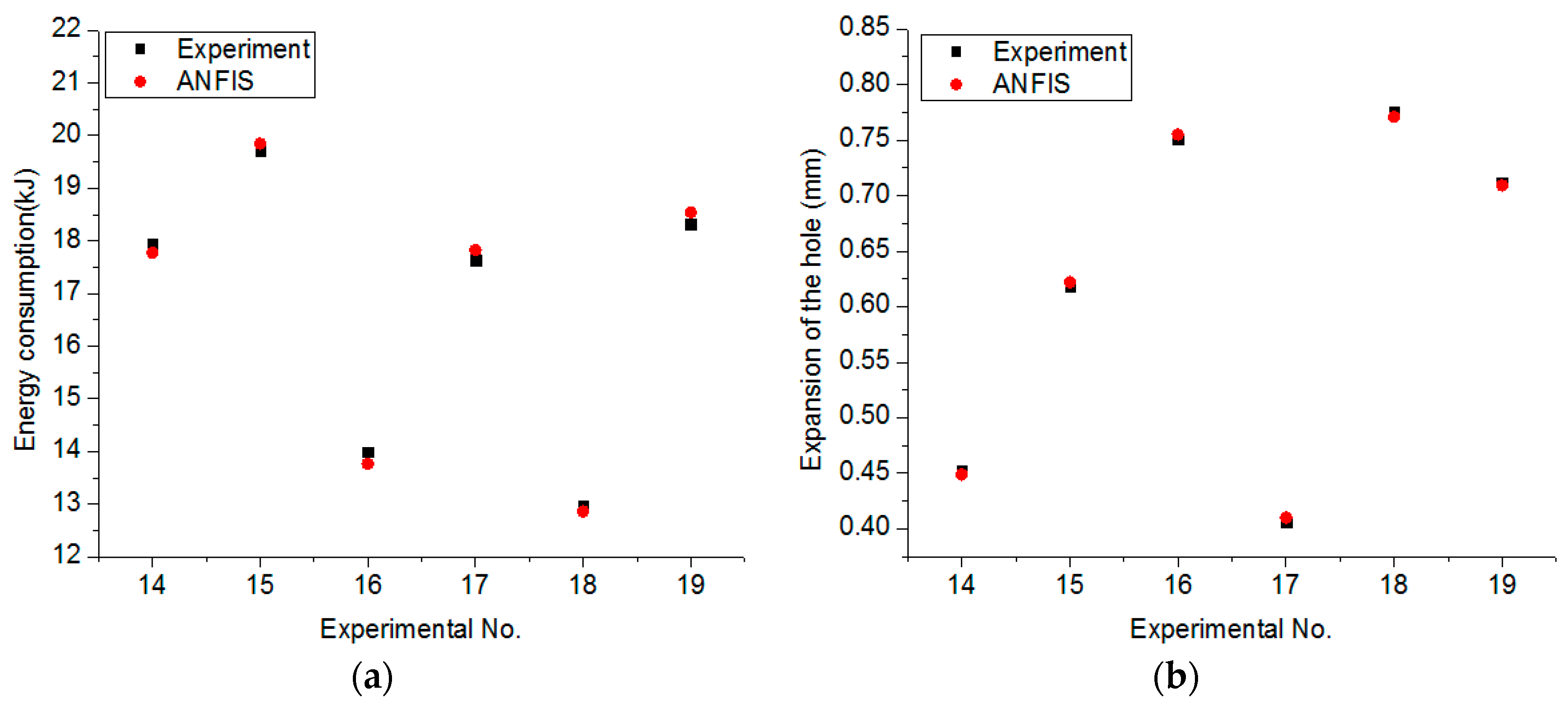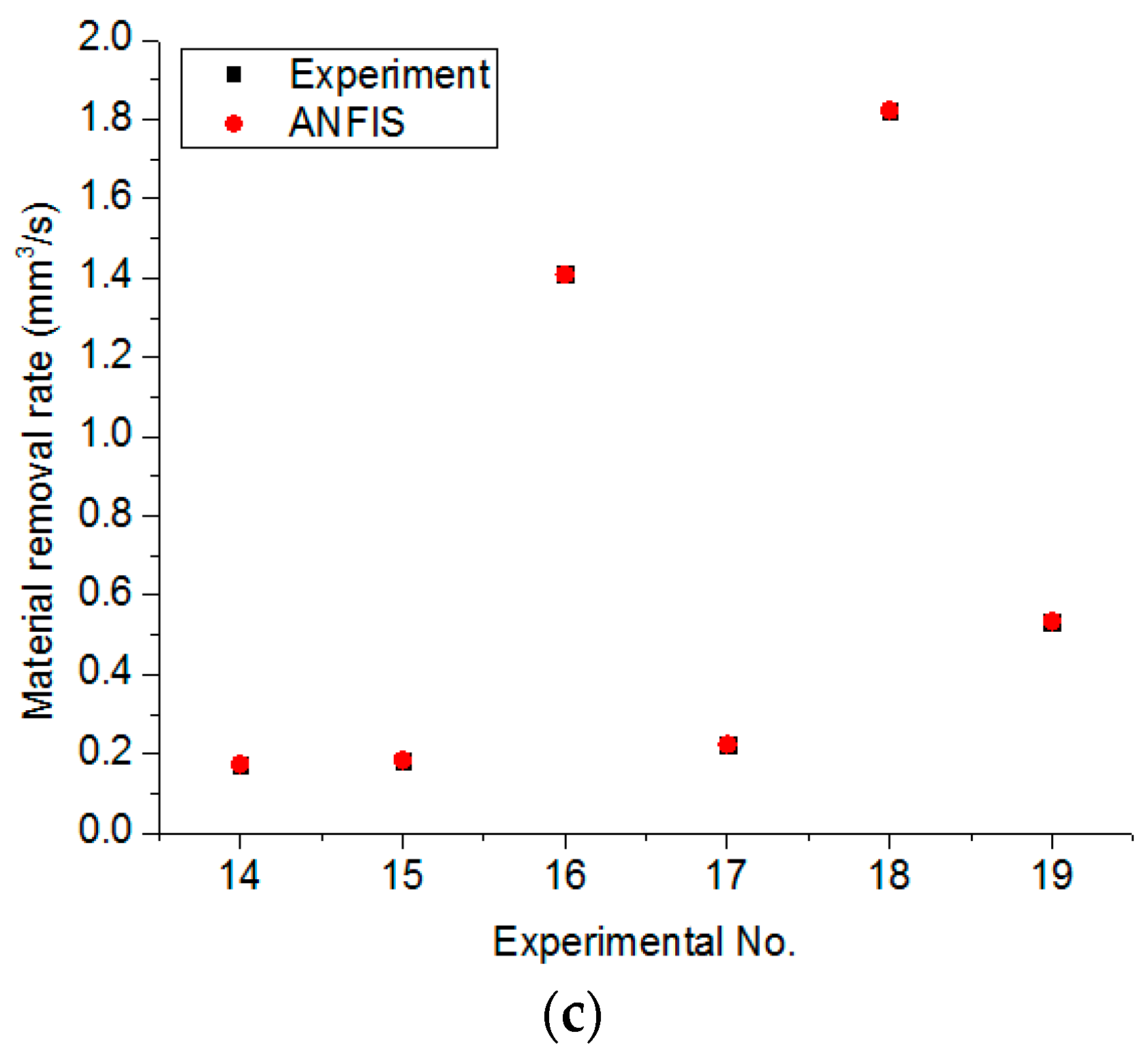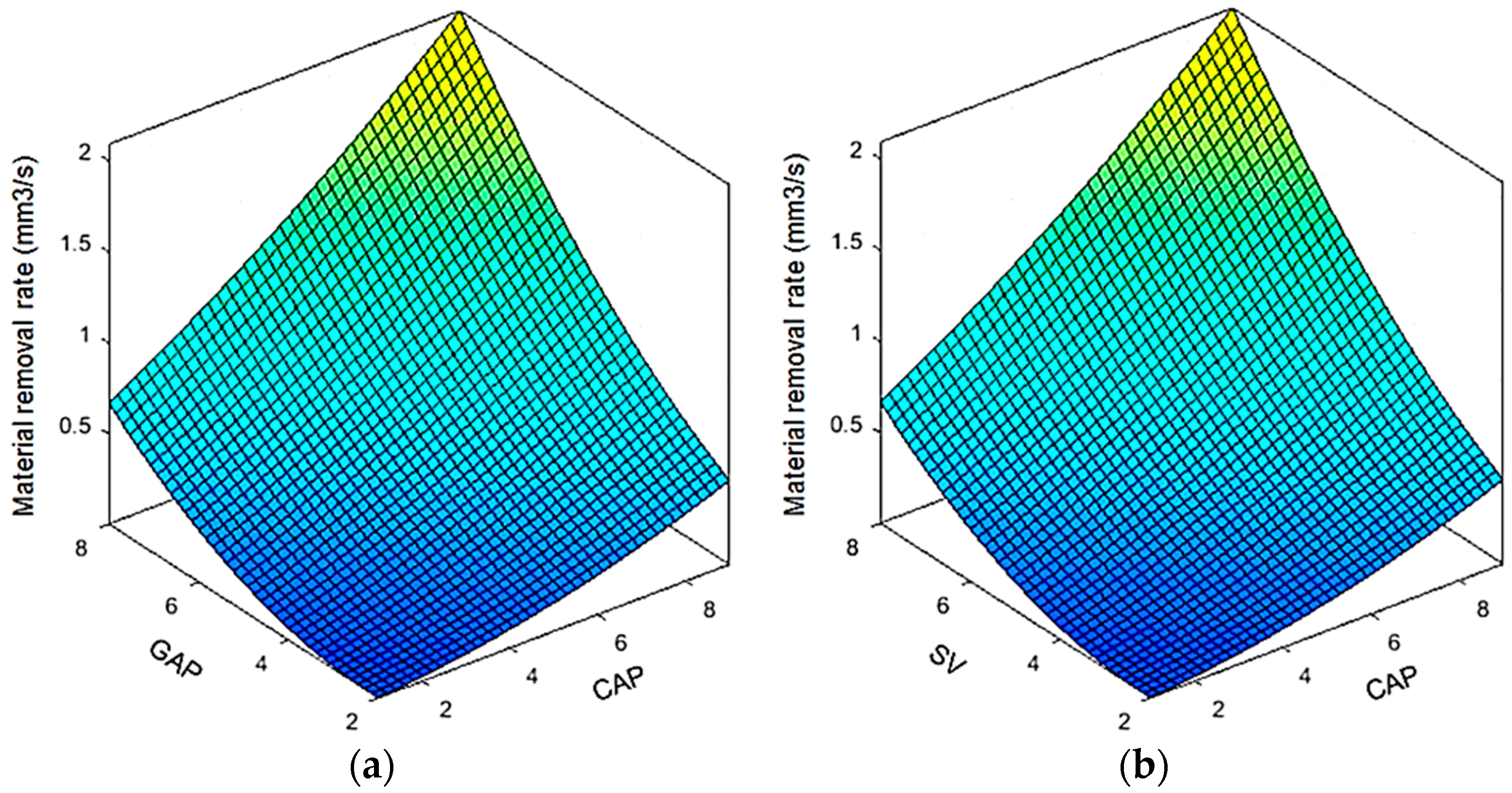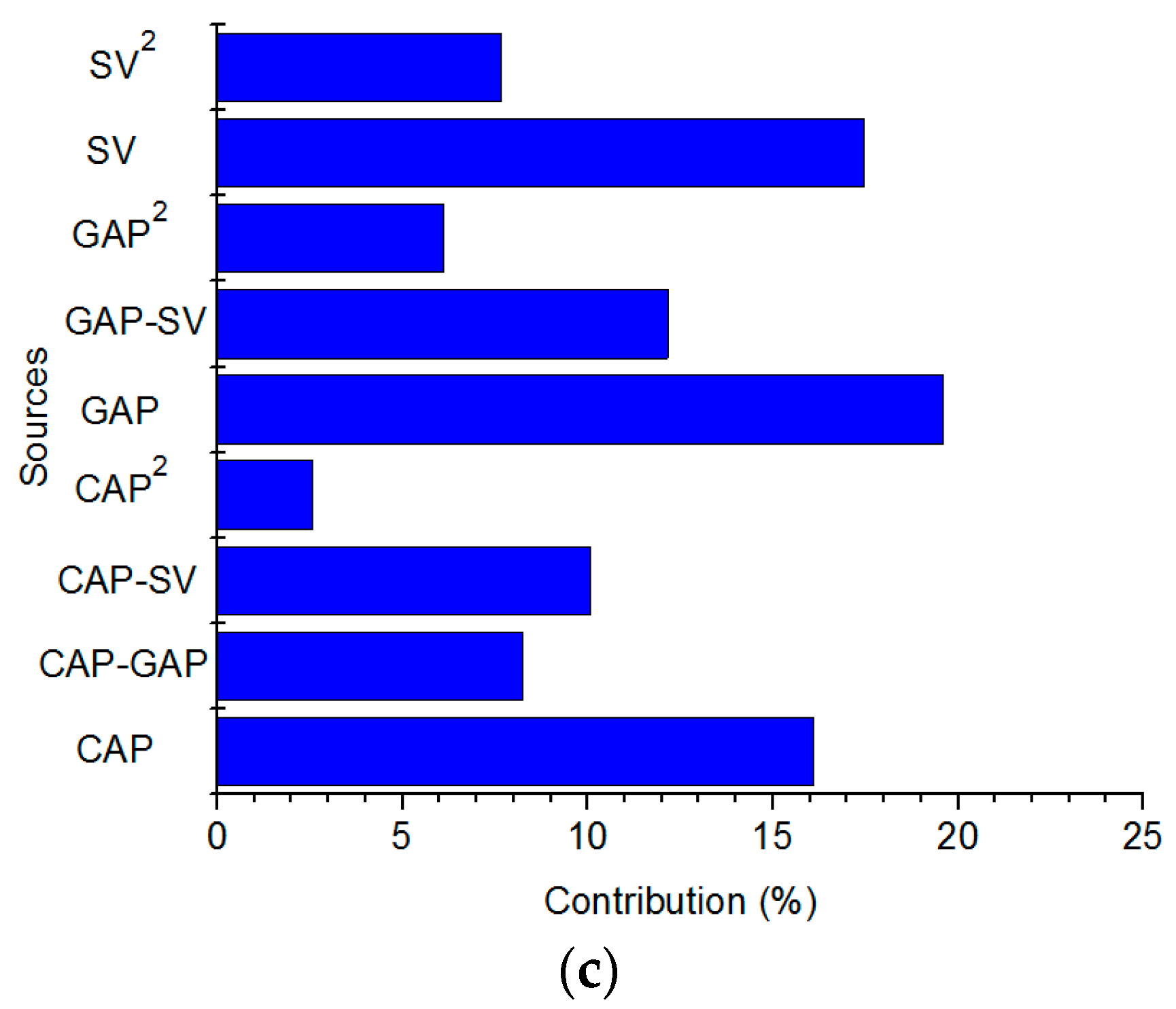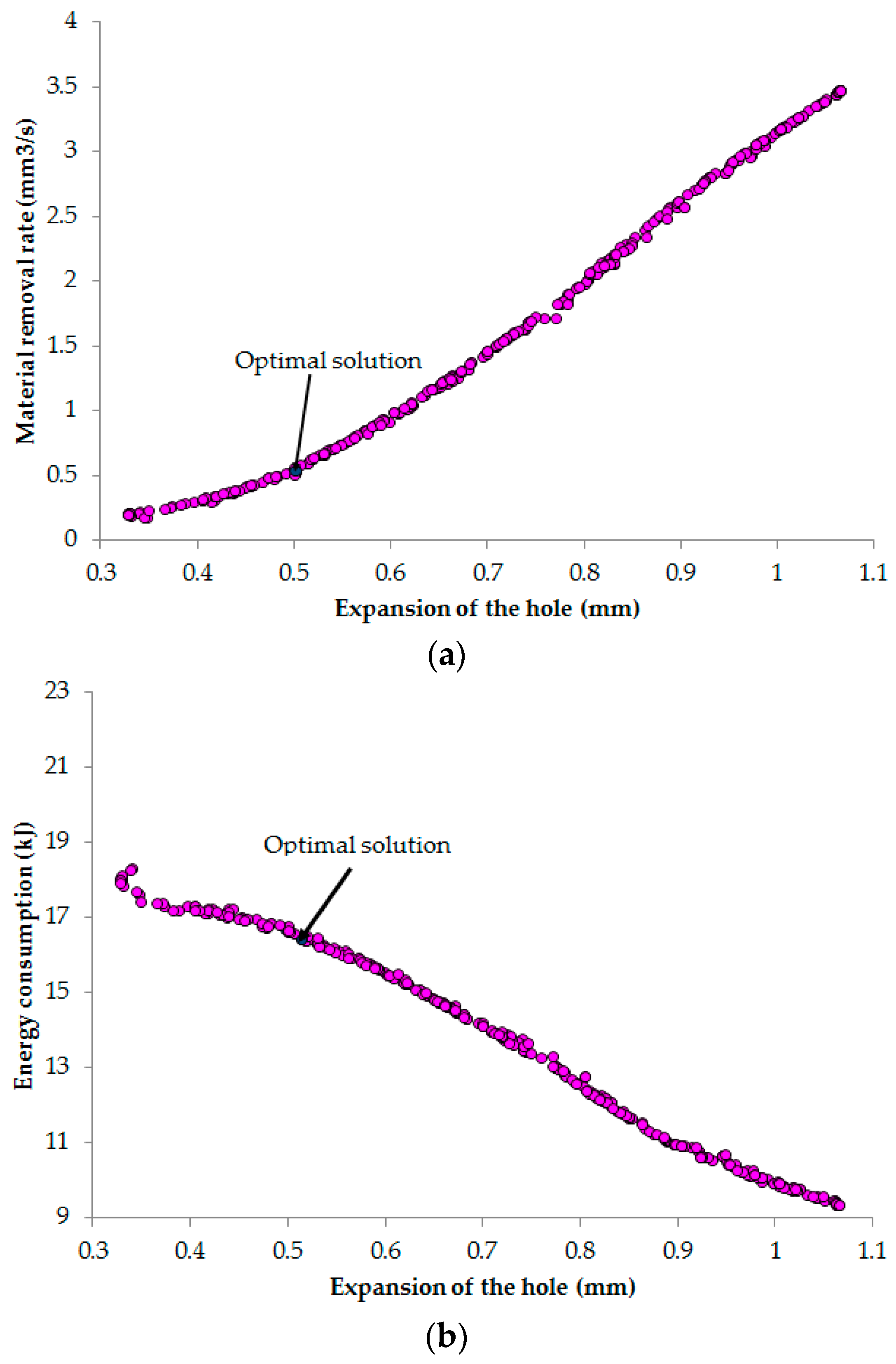1. Introduction
Electrical discharge machining (EDM) operation is an efficient approach to machine difficult-to-cut materials [
1]. EDM processes are extensively applied in industrial applications to produce complex shapes and to achieve high precision. For EDM operations, the material is removed from the surface of a conductive specimen with the support of electrical sparks between the electrode and workpiece. Various EDM processes, including the die-sinking EDM, wire-EDM, powder-mixed EDM, micro-EDM, and dry EDM, were appropriately applied to produce small, fragile, and delicate components due to non-machining forces applied [
2]. Furthermore, the EDM process is effectively used to machine the components with different dimensional scales. Unfortunately, EDM operations can only be employed on the electrically conductive workpiece. These processes also have low productivity (e.g., material removal rate), high energy consumed, and low machined quality (e.g., high surface roughness). It is difficult to achieve the precision of the machined shape corner due to the tool wear. The electrode consumption is another factor that has a negative impact on production costs.
The principle of the EDD process is familiar with that of the EDM method. It is a thermal-electric process, which uses a series of discrete sparks to remove the material from the electrically conductive workpiece. The gap between the electrode and the specimen is generated in the dielectric. The dielectric is ionized to form an electric bridge on gaps, which produces the electrical spark. For the EDD process, the long electrode with the internal dielectric fluid rotates around the spindle center. The metal is quickly expelled as the series of ionized dielectric vapor collapse. Electrode rotation provides better flushing, which significantly contributes to the uniformity of the hole profile. It can be stated that the EDD operation is developed to drill holes quickly in the production of turbine blades, coolant lines, ejector holes, mold vent holes, and other industrial applications.
During blind hole drilling, the material is molten and ejected due to electrode rotation. The debris particles are cooled down and accumulated at the bottom surface of the tool. The heap of accumulated debris is produced at the hole bottom due to the vortex motion. The debris is removed in the processing time with the support of a high pressure flow.
Many researchers have previously performed parameter-based optimizations for enhancing the technical responses of the EDD processes. A model of the wear of electrodes was developed for the EDD operation of the die material [
3]. The outcomes indicated that the wear amount can be precisely forecast. Yildiz et al. [
4] developed the empirical correlation of the depth of the recast layer regarding the applied current (AC), pulse on time (T
on), and pulse off time (T
off) for beryllium copper. The authors stated that the regression model had acceptable accuracy. The second-order models of the roughness (R), circularity (CIR), and machining rate (MR) were developed for the EDD process of the super alloy [
5]. The optimal values helped in the improvements in MRR, R, and CIR were 82.3%, 39.3%, and 25.0%, respectively. An autonomous system was developed to achieve the optimal factors for minimizing the drilling time (DT), tool wear (TW), and R [
6]. The neuro-fuzzy inference technique was utilized to depict the relations between the processing inputs and technological outputs. A new EDD process with the diamond electrode was developed to minimize the R and CIR of the drilled nickel alloy [
7]. The significant enhancements of the R and CIR are around 25% and 29%, as compared to the traditional one. The optimized parameters were determined to reduce the R and DT of the EDD operation of nickel alloy [
8]. The findings revealed that the AC was found to be the most affected factor.
The process inputs, including the AC, T
on, tool speed (TS), flow rate (FR), and pressure (P) on the MRR, R, and overcut (OC) for the EDD process were analyzed by Yadav et al. [
9]. The explored outcomes revealed that the low cracks, debris, and craters could be achieved using the near-dry EDD implementation. A dry EDD process was proposed to enhance the productivity of the machined characteristics of the composite material [
10]. The author stated that the MRR produced by dry EDD could be improved by 200%, as compared to the oil-based one. The oxygen-based EDD depicted better efficiency than the air-based EDD. The impacts of the geometry of the electrode, tool speed (TS), voltage (VO), and capacitance (CA) on the MRR, OC, and tapper angle (TAP) for the EDD process of the stainless steel 316 were analyzed [
11]. The authors stated that the CA was found to be the most effective input, followed by the polarity, the TS, and VO. The optimal values of the polarity, TS, VO, and CA were the positive shape, 250 RPM, 100 V, and 0.01 nf. The correlated models of the MR, TW, OC, and TAP were proposed regarding the AC, TS, and the P with the aid of the artificial neural network [
12]. The author stated that the AC was the most affecting factor and the proposed model could provide the minimal error. The optimum factors of the AC, TS, and the P were 10.18 A, 100 RPM, and 58.78 bar.
The effects of the process inputs, including the T
on, VO, and ultrasonic vibration on the recast layer thickness (TL), micro-hardness (MH), and the chemical composition of the micro-holes for the EDM process have been analyzed [
13]. The findings revealed that the depth value of the recast layer is in the range of 9–23 μm. The micro-hardness value is in the range of 166–200 HV. The machined surface contains lower amounts of carbon, oxygen, and tungsten. A novel turning spindle was developed to produce the free-form cylindrical geometries on SS304 specimens [
14]. The impacts of the T
on, AC, VO, and tool thickness (TN) on the MRR and TW were investigated. The authors stated that the T
on was the most effective factor that affected the MRR and TW, followed by the VO, TN, and AC, respectively. The second-order model of the roughness in terms of the T
on, T
off, and AC was developed for the EDM process of SS304 [
15]. Moreover, the authors stated that the AC and T
on were significant factors. The influence of the polarity on the TW and MRR for the micro EDM process of SS304 was explored by Boban et al. [
16]. The outcomes revealed that the direct polarity has an effective contribution to a reduction in the TW and maximization of MRR.
Pandey et al. [
17] used a hybrid algorithm to optimize the T
on, T
off, P, and AC for minimizing the CIR, TAP, and dilation (DI) of the drilled nickel alloy. The outcomes revealed that the correlations may be applied for the prediction of EDD responses. The desirable values of the T
on, T
off, P, and AC were 8 μs, 7 μs, 60 bar, and 10 Amp, respectively. The advantages of the cryogenic cooling-based EDD operation were explored by Manivannan and Kumar [
18]. The authors presented that the enhancements in the MRR and roughness were 62% and 36%. The effectiveness of the varied electrodes on the MRR, TW, OC, R, and aspect ratio (AR) was analyzed in the drilling of AISI 304 [
19]. Elliptical shape was considered as the best solution to obtain higher MRR and lower TW. The elliptical geometry may be used to observe less OC, lower R, and higher AR. Ununea et al. [
20] revealed that the hole quality (OC and TAP) and productivity (MRR and TW) of the EDD process for Inconel 718 could be improved with the support of a vibration-assisted module. The authors emphasized that the vibration significantly helped to remove the debris and improve the flushing as well as the machining stability. The influences of the different tool materials on the MRR, TW, TAP, OC, and roughness of the drilled SS 316L were analyzed [
21]. The outcomes revealed that the tungsten tool contributed to the lowest values of the TWR as well as OC and the MRR could be improved using the copper tool. Moreover, a smooth surface was obtained at low discharge energy. The effects of the T
on, V, and CA on the dimple responses (depth, height, and width) for the EDD operation of a titanium alloy were analyzed by Jung et al. [
22]. The predictive correlations with 95% confidence were designed. The optimum values of the T
on, V, and CA were 100 μs, 180 V, and 10,000 pF, respectively. The impacts of the AC, T
on, TS, and duty cycle (DC) on the MR, TW, and OC on the EDD operation of mold material were investigated by Singh et al. [
23]. The authors stated that the EDD operation employing the rotary electrode provided a higher MRR and a lower TWR as well as OC.
The regression models were used to address the correlations between inputs (AC, T
on, T
off, and P) and the hole quality (CIR, TAP, and expansion) of the drilled titanium [
24]. The authors emphasized that the proposed formulas can be accurately used to estimate the response values. The general improvements of the EDD responses are around 59%. A new measurement is proposed to explore the TW of the drilled hole [
25]. The error of 1% revealed the effectiveness of the measuring method. The machining program will be updated after each operation to decrease the idle time. The influences of various fluids on the formation of the white layer were analyzed by Li et al. [
26]. The author concluded that a higher conductivity of the fluid resulted in a thicker white layer and an increased cooling speed caused a thin affected layer. Moreover, the lowest thickness of the white layer could be obtained with the support of the kerosene fluid. The impacts of various fluids on the MR, TW, and hole properties were experimentally explored for the EDM process of the titanium [
27]. The author stated that the mixture of the Cu powder and dielectric fluid significantly enhanced the EDD responses. The influences of the TS, AC, T
on, and FR, and the quantity of oxygen on the MRR, OC, and surface characteristics were thoroughly explored [
28]. The outcomes revealed that the oxygen gas-assisted EDD process has an efficient contribution to improve the MRR and decrease the thicker layer as well as the OC.
The inputs considered are the processing conditions (AC, Ton, Toff, and VO), the electrode’s characteristics (geometry and materials), dielectric properties (type, dielectric strength, and viscosity), and the workpiece materials. The technological responses considered are the hole quality (CIR, TAP, DI), surface properties, MRR, and TW. However, the drawbacks of the published works are listed as follows:
The impacts of the advanced parameters, including the gap voltage adjustor (GAP), capacitance parallel connection selecting (CAP), and servo sensitivity selection (SV) on the EDD responses, such as energy consumed, the hole quality, and productivity have not been thoroughly considered. These parameters have efficient impacts on the machining speed, energy stability, and the formation of the hole. The formulations having acceptable accuracy between the advanced parameters and the performances measured for the EDD operations have not been considered in the works. The selection of optimal values of these factors for maximizing the hole quality as well as machining rate and minimal drilled energy has not been considered in the works published. The regression models, such as the linear and second-order formulations were widely applied to depict the relations between the processing inputs and machining characteristics in the EDD optimizations. Unfortunately, these mentioned approaches have low predictive accuracy due to the approximate behavior [
29,
30]. It is necessary to propose a higher accurate forecasting model for the optimization issues in the EDD process. The Taguchi method and Taguchi-based approaches have been widely used to select the optimal factors in EDD optimization. However, the optimal outcomes selected from the experimental data have a high risk of obtaining the local result, which leads to inefficient optimization. The development of a new optimization method is an urgent demand to guarantee the selection of global results.
This work presents an optimizing approach of the EDD process of the stainless steel 304 (SS304) to minimize the HE and the ED, while MRR is to be maximized. SS304 is a common stainless steel, which is widely applied in industrial applications for automotive, molding, and aerospace components [
31]. It is a difficult-to-cut material due to the superior characteristics, including the good corrosion resistance, chemical reaction resistance, low thermal conductivity, and high strength in the high temperature working conditions. The interpolative ANFIS correlations are used to establish relations between the advanced conditions and EDD responses. The NCGA is utilized to generate feasible solutions and determine the best design point.

